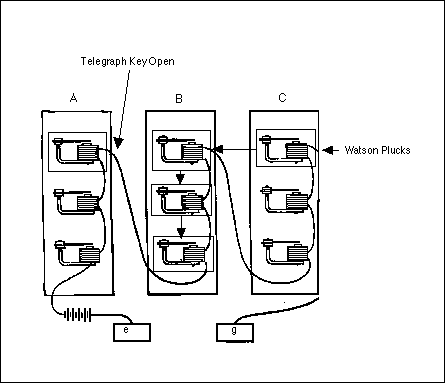
June 2, 1875 (Deposition, pp. 57-60). Bell set up three multiple telegraph stations, A, B and C, each with three tuned-reed receivers similar to the ones in his patent of March 7th. He wanted to be able to pluck the first reed in A and have the correspondinbg reeds in B & C vibrate. Naturally, these reeds were very difficult to tune and required constant adjustment--shortening or lengthening. On June 2, Bell was supervising A & B & Watson was in another room working with C. When Bell depressed the telegraph key corresponding to one of the reeds at A, the corresponding reed at B vibrated well, but Watson said C was stuck. To release it, Watson plucked it; Bell noticed that this caused the corresponding reed at B to vibrate powerfully. Bell then listened to each of the reeds at B in succession, placing his ear right against them, and heard both the pitch and timbre of the pluck. At the end of a day of experimenting, Bell tried connecting two reeds without a battery in the circuit; plucking one threw the other into such powerful vibration that it could operate Bell's vibratory circuit breaker (Patent No. 161, 739; April 6, 1875)."These experiments at once removed the doubt that had been in my mind since the summer of 1874, that magneto-electric currents generated by the vibration of an armature in front of an electro-magnet would be too feeble to produce audible effects that could be practically utilized for the purposes of multiple telegraphy and of speech-transmission" (p. 59). Picture is from The Telephone Appeals, p. 41.
Date Last Modified: Nov 1,1994